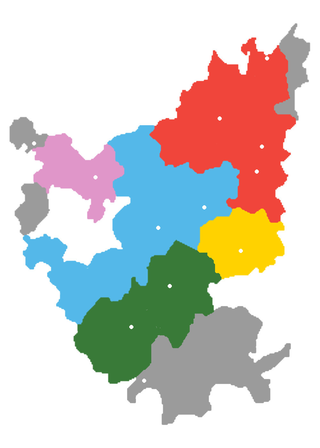New Xiang
| New Xiang | |
|---|---|
| Chang-Yi | |
| 长益片 | |
| Native to | People's Republic of China |
| Region | Hunan |
| Chinese characters | |
| Language codes | |
| ISO 639-3 | None (mis) |
| ISO 639-6 | cayi |
| Glottolog | chan1316 |
| Linguasphere | 79-AAA-eaa |
 New Xiang is in red. It is in contact with Southwestern Mandarin to the northwest, Gan to the east, Old Xiang to the west, and Hengzhou Xiang to the south (yellow). | |
New Xiang, also known as Chang-Yi (simplified Chinese: 长益片; traditional Chinese: 長益片; pinyin: Chǎng Yì piàn; lit. 'Changsha and Yiyang subgroup') is the dominant form of Xiang Chinese. It is spoken in northeastern areas of Hunan, China adjacent to areas where Southwestern Mandarin and Gan are spoken. Under their influence, it has lost some of the conservative phonological characteristics that distinguish Old Xiang. While most linguists follow Yuan Jiahua in describing New Xiang as a subgroup of Xiang Chinese,[1] Zhou Zhenhe and You Rujie classify it as Southwestern Mandarin.[2][3] However, New Xiang is still very difficult for Mandarin speakers to understand, particularly the old style of New Xiang.
Dialects and regions
[edit]New Xiang-speaking cities and counties are mainly located in the northeast part of Hunan, the lower river of Xiang and Zi. The Changsha dialect is representative.[clarification needed] There are three main subdialects under New Xiang.
- Chang-Tan
- Urban Changsha, Changsha County, Wangcheng District, Ningxiang, Liuyang*, Xiangyin, Miluo, Nanxian, Urban Zhuzhou, Zhuzhou County, Urban Xiangtan, Xiangtan County, Nanxian
- Yi-Yuan
- Urban Yiyang, Yuanjiang, Taojiang
- Yueyang
- Yueyang County, Yueyang
Suantang (酸汤) is a lect spoken by about 80,000 ethnic Miao people in Baibu (白布), Dihu (地湖), Dabaozi (大堡子), and Sanqiao (三锹) in Tianzhu, Huitong, and Jing counties of Hunan province.[4] It is very similar to New Xiang, but it is unintelligible with Southwestern Mandarin.[5][6]
References
[edit]- ^ Norman, Jerry (1988). Chinese. Cambridge: Cambridge University Press. p. 207. ISBN 0-521-22809-3.
- ^ Zhou, Zhenhe 周振鹤; You, Rujie 游汝杰 (1986). Fāngyán yǔ Zhōngguó wénhuà 方言与中国文化 [Dialects and Chinese Culture] (in Chinese). Shanghai: Shanghai renmin chubanshe.
- ^ Kurpaska, Maria (2010). Chinese Language(s): A Look Through the Prism of "The Great Dictionary of Modern Chinese Dialects". Berlin: De Gruyter Mouton. p. 55. ISBN 978-3-11-021914-2.
- ^ Chen, Qiguang 陈其光 (2013). Miáo-Yáo yǔwén 苗瑶语文 [Miao and Yao Language] (in Chinese). Beijing: Zhongyang minzu daxue chubanshe. p. 35.
- ^ Yu Dazhong [余达忠]. 2017. "Ethnic Interactions and the Formation of the Sanqiu People in the Borderland of Modern Hunan, Guizhou and Guangxi Provinces [近代湘黔桂边区的族群互动和“三锹人”的形成]". In Journal of Guizhou Education University [贵州师范学院学报], Vol. 33, No. 1 (Jan 2017).
- ^ Chen Qiguang [陈其光] (2013). Miao and Yao language [苗瑶语文]. Beijing: Ethnic Publishing House [民族出版社]. ISBN 9787566003263


